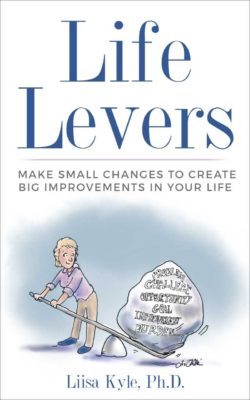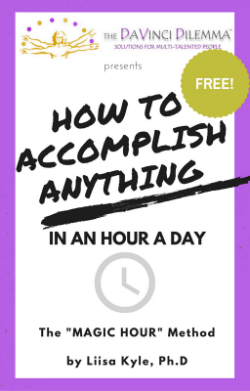
image via commons.wikimedia.org
As a DaVinci — a smart, creative person juggling many ideas, talents and projects — you’ve got a lot to contribute. Maybe too much. You may be giving SO MUCH input, you’re inadvertently stifling the contributions of others. Or, worse, irritating them.
Does this sound like you:
1. On the phone or in meetings, do you tend to speak at the same time as others?
2. Do you think out loud? Do you start speaking, formulating your sentences as a way of figuring out what you want to say?
3. Are you a super-verbal person? Do you speak quickly and extemporaneously?
4. Have you been described as intimidating –especially in meetings?
If yes, rest assured that you are not alone. Many of my coaching clients find themselves ‘over-contributing’. Like you, they are fast thinking, creative people who generate a kajillion ideas every day. It’s natural to want to share thoughts as soon as they occur.
So what’s the problem?
Look at the people with whom you’re interacting. How are they responding to your contributions? Are they responding in kind? Or does it seem like they’ve given up trying to get in the conversation? Do they seem happy — or frustrated or annoyed? If your colleagues are fully energized and engaged by your passionate contributions, terrific. HOWEVER, if they’re not — if they seem withdrawn or irritated or bored, your zeal may be inadvertently damaging your working relationships.
Okay, maybe my colleagues don’t look delighted. What’s the solution?
It’s great to have a lot to contribute. And it might behoove you to adapt your delivery a bit, for the sake of improving your working relationships. Specifically, when you have something to say, employ a Five Second Delay before you speak. Use these five seconds to
(a) formulate your point completely (yes…before you begin to speak), and
(b) decide the best way to contribute it, if at all. Does it make sense to blurt out your point verbally in this particular moment? Would it serve you (or others) more to receive it via email or in an off-line conversation later? Does it really need to be said? By you? At this particular time? Use your considerably brain power to consider your options and to choose what makes sense.
Why implement a Five Second Delay?
1. You’ll enhance your verbal power.
When you use the extra time to formulate your point, you’ll be able to express it more succinctly, clearly and effectively.
2. It will literally slow you down.
Your mind works much faster than the average person. Given your rapid-fire cognitions, your verbal input can seem almost like you’re ‘pouncing’. By pausing a few seconds, you’re less apt to be ‘pouncing’ and more likely to be ‘presenting’ your point.
3. It’s nice.
The five second delay is a polite way to share your contributions — as a way of adjusting your pace so others feel more comfortable.
4. It allows others to participate.
You don’t need to be the one conveying every idea. By pausing a few seconds, you may find that someone else has the same idea — but hasn’t had the opportunity to express it.
Especially introverts. Whereas most extraverts think aloud like you do, introverts compose their thoughts completely prior to uttering a word. Even when you know this, it can be painful for an extravert to wait for an introvert to respond. For example, when I ask my husband, a rabid introvert, a question, the several seconds it takes for him to formulate his response can seem like an eternity. Even though I *know* he IS actually answering my question, I can get impatient if something urgent is going on. If I start to hop up and down, he’s learned to hold up a hand and say “processing” to remind me what’s going on in his head.
(Yes, the Five Second Delay technique can be profitably applied to personal relationships, too).
5. You’ll get more information.
When you give people more time to answer, they’ll tell you more. There’s a natural human urge to fill any lull. By creating mini-lulls, you’ll create more opportunities for input.
***
 Want more tips and techniques for getting things done? Check out my book YOU CAN GET IT DONE: Choose What to do, Plan, Start, Stay on Track, Overcome Obstacles, and Finish
Want more tips and techniques for getting things done? Check out my book YOU CAN GET IT DONE: Choose What to do, Plan, Start, Stay on Track, Overcome Obstacles, and Finish
Available here in paperback and e-book formats: http://bit.ly/YouCanGetItDone
***
Want to re-publish this article? Go for it – just include the author’s name, a link to this original post and the following text blurb:
Are you struggling with too many talents, skills, ideas? You may have The DaVinci Dilemma™! Find tools, fun quizzes, coaching, inspiration and solutions for multi-talented people at http://www.davincidilemma.com/ .



